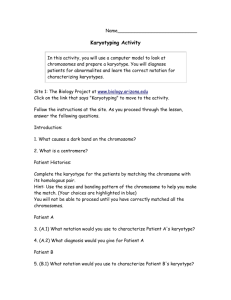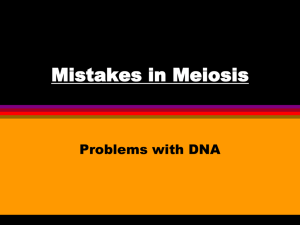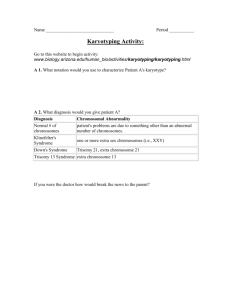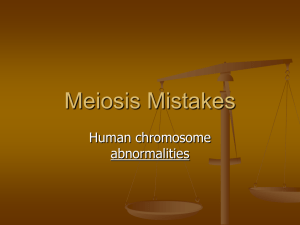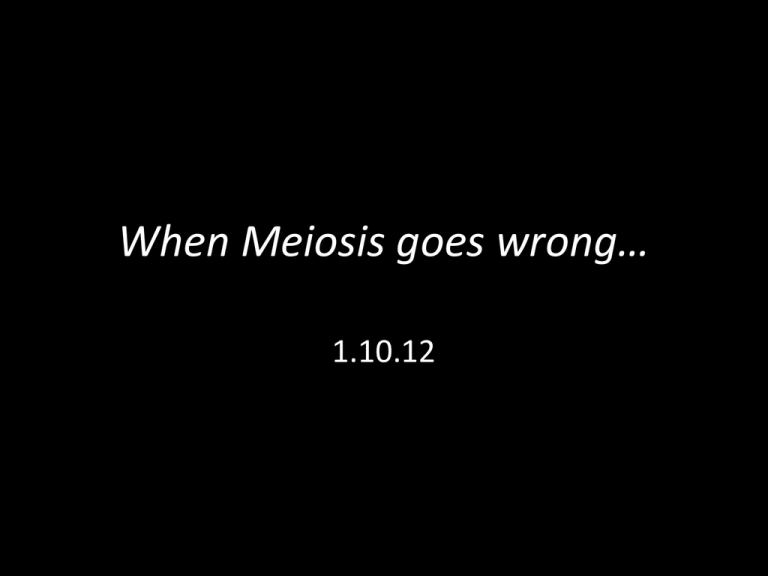
When Meiosis goes wrong…
1.10.12
What can go wrong during meiosis?
What can go wrong during meiosis?
• Nondisjunction – The failure of homologous
chromosomes or non-sister chromatids to
separate during anaphase I or anaphase II
What can go wrong during meiosis?
• Nondisjunction – The failure of homologous
chromosomes or non-sister chromatids to
separate during anaphase I or anaphase II
– One gamete ends up with two copies of a
chromosome, the other with zero
– Mitosis then spreads this chromosomal error
throughout the organism
Alteration of Chromosome #
• Trisomy = 3 copies of a particular chromosome
• Monosomy = 1 copy
Alteration of Chromosome #
• Trisomy = 3 copies of a particular chromosome
• Monosomy = 1 copy
• Polyploidy = double/triple/etc. of entire
genome (whole set of chromosomes)
– Kills animals (prevents development), but makes
plants bigger and stronger
– Can occur from 2 sperm fertilizing 1 egg or by a
diploid gamete
Alteration of Chromosome #
• It is common for humans to have an irregular
# of chromosomes, but usually disastrous
• 1/3 of all pregnancies end in spontaneous
abortions (natural miscarriage), and ½ of
these are due to nondisjunction
Down’s Syndrome (Trisomy 21)
Down’s Syndrome (Trisomy 21)
• 3 copies of chromosome #21
• 1 in 500 children in U.S.
• Flattened face, short stature, mental
retardation, shortened lifespan, heart defects,
sterile
Down’s Syndrome (Trisomy 21)
• Occurrence directly related to maternal age
– Under 30
Down’s Syndrome (Trisomy 21)
• Occurrence directly related to maternal age
– Under 30
1 in 952
Down’s Syndrome (Trisomy 21)
• Occurrence directly related to maternal age
– Under 30
– Under 35
1 in 952
Down’s Syndrome (Trisomy 21)
• Occurrence directly related to maternal age
– Under 30
– Under 35
1 in 952
1 in 378
Down’s Syndrome (Trisomy 21)
• Occurrence directly related to maternal age
– Under 30
– Under 35
– Under 40
1 in 952
1 in 378
Down’s Syndrome (Trisomy 21)
• Occurrence directly related to maternal age
– Under 30
– Under 35
– Under 40
1 in 952
1 in 378
1 in 106
Down’s Syndrome (Trisomy 21)
• Occurrence directly related to maternal age
– Under 30
– Under 35
– Under 40
– Under 45
1 in 952
1 in 378
1 in 106
Down’s Syndrome (Trisomy 21)
• Occurrence directly related to maternal age
– Under 30
– Under 35
– Under 40
– Under 45
1 in 952
1 in 378
1 in 106
1 in 30
Down’s Syndrome (Trisomy 21)
• Occurrence directly related to maternal age
– Under 30
– Under 35
– Under 40
– Under 45
– Under 50
1 in 952
1 in 378
1 in 106
1 in 30
Down’s Syndrome (Trisomy 21)
• Occurrence directly related to maternal age
– Under 30
– Under 35
– Under 40
– Under 45
– Under 50
1 in 952
1 in 378
1 in 106
1 in 30
1 in 11
Down’s Syndrome (Trisomy 21)
• Occurrence directly related to maternal age
–
–
–
–
–
Under 30
Under 35
Under 40
Under 45
Under 50
1 in 952
1 in 378
1 in 106
1 in 30
1 in 11
• Trisomy 13, 15, and 18 also occur, but die shortly
after birth. All other human trisomies fail to
develop
Nondisjunction of Sex Chromosomes
• Far less serious
• Why?
– Y chromosome carries very few genes
– X chromosome will mostly shrivel up into an
inactive state if an extra is present (Barr body)
Klinefelter’s Syndrome (XXY)
•
•
•
•
1 in 2,000 births
Underdeveloped male sex organs
Feminine secondary characteristics
Sterile
XYY
• 1 in 1,000
• Normal looking male
• Tall with relatively severe acne
XXX
• 1 in 1,000
• Tall female with irregular menstrual cycle
• Otherwise normal, needs karyotype (picture of
chromosomes) for diagnosis
Turner’s Syndrome (XO)
Turner’s Syndrome (XO)
• 1 in 2,000 female births
• Only viable monosomy (the only chromosome
that humans can survive with only one copy
of)
Turner’s Syndrome (XO)
• 1 in 2,000 female births
• Only viable monosomy (the only chromosome
that humans can survive with only one copy
of)
• Normal until puberty
• Short, sterile, no secondary sex characteristics,
normal intellect, treatable with hormone
therapy




